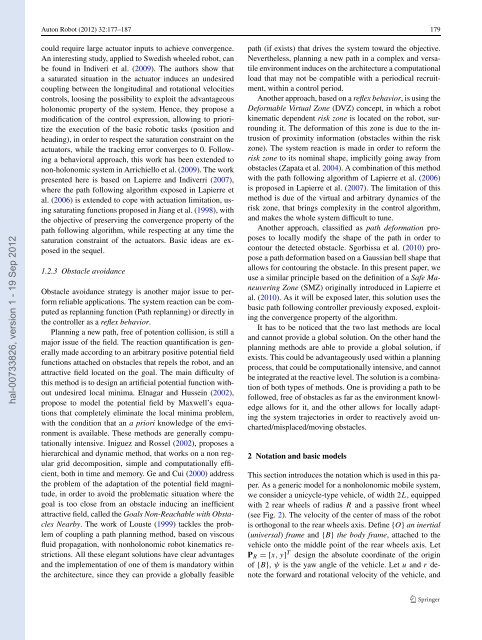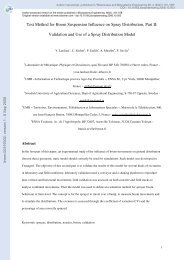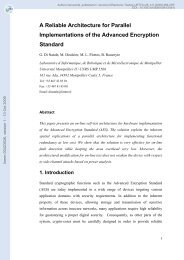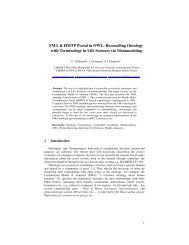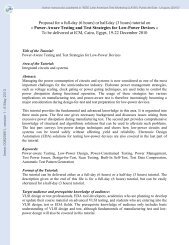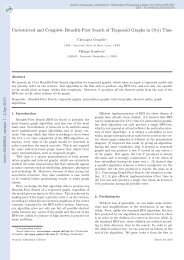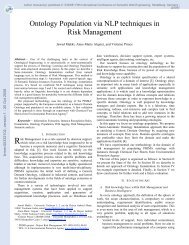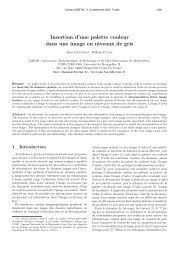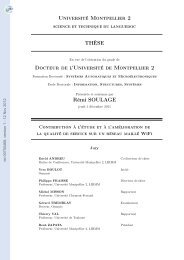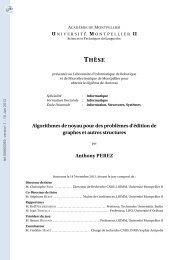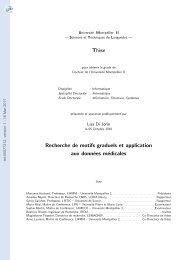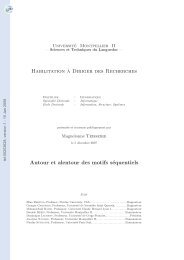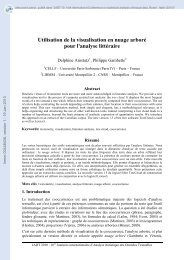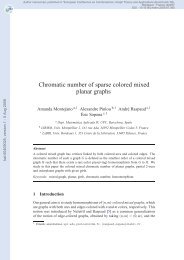A guaranteed obstacle avoidance guidance system: The safe ...
A guaranteed obstacle avoidance guidance system: The safe ...
A guaranteed obstacle avoidance guidance system: The safe ...
You also want an ePaper? Increase the reach of your titles
YUMPU automatically turns print PDFs into web optimized ePapers that Google loves.
hal-00733826, version 1 - 19 Sep 2012<br />
Auton Robot (2012) 32:177–187 179<br />
could require large actuator inputs to achieve convergence.<br />
An interesting study, applied to Swedish wheeled robot, can<br />
be found in Indiveri et al. (2009). <strong>The</strong> authors show that<br />
a saturated situation in the actuator induces an undesired<br />
coupling between the longitudinal and rotational velocities<br />
controls, loosing the possibility to exploit the advantageous<br />
holonomic property of the <strong>system</strong>. Hence, they propose a<br />
modification of the control expression, allowing to prioritize<br />
the execution of the basic robotic tasks (position and<br />
heading), in order to respect the saturation constraint on the<br />
actuators, while the tracking error converges to 0. Following<br />
a behavioral approach, this work has been extended to<br />
non-holonomic <strong>system</strong> in Arrichiello et al. (2009). <strong>The</strong> work<br />
presented here is based on Lapierre and Indiverri (2007),<br />
where the path following algorithm exposed in Lapierre et<br />
al. (2006) is extended to cope with actuation limitation, using<br />
saturating functions proposed in Jiang et al. (1998), with<br />
the objective of preserving the convergence property of the<br />
path following algorithm, while respecting at any time the<br />
saturation constraint of the actuators. Basic ideas are exposed<br />
in the sequel.<br />
1.2.3 Obstacle <strong>avoidance</strong><br />
Obstacle <strong>avoidance</strong> strategy is another major issue to perform<br />
reliable applications. <strong>The</strong> <strong>system</strong> reaction can be computed<br />
as replanning function (Path replanning) or directly in<br />
the controller as a reflex behavior.<br />
Planning a new path, free of potention collision, is still a<br />
major issue of the field. <strong>The</strong> reaction quantification is generally<br />
made according to an arbitrary positive potential field<br />
functions attached on <strong>obstacle</strong>s that repels the robot, and an<br />
attractive field located on the goal. <strong>The</strong> main difficulty of<br />
this method is to design an artificial potential function without<br />
undesired local minima. Elnagar and Hussein (2002),<br />
propose to model the potential field by Maxwell’s equations<br />
that completely eliminate the local minima problem,<br />
with the condition that an aprioriknowledge of the environment<br />
is available. <strong>The</strong>se methods are generally computationally<br />
intensive. Iniguez and Rossel (2002), proposes a<br />
hierarchical and dynamic method, that works on a non regular<br />
grid decomposition, simple and computationally efficient,<br />
both in time and memory. Ge and Cui (2000) address<br />
the problem of the adaptation of the potential field magnitude,<br />
in order to avoid the problematic situation where the<br />
goal is too close from an <strong>obstacle</strong> inducing an inefficient<br />
attractive field, called the Goals Non-Reachable with Obstacles<br />
Nearby. <strong>The</strong> work of Louste (1999) tackles the problem<br />
of coupling a path planning method, based on viscous<br />
fluid propagation, with nonholonomic robot kinematics restrictions.<br />
All these elegant solutions have clear advantages<br />
and the implementation of one of them is mandatory within<br />
the architecture, since they can provide a globally feasible<br />
path (if exists) that drives the <strong>system</strong> toward the objective.<br />
Nevertheless, planning a new path in a complex and versatile<br />
environment induces on the architecture a computational<br />
load that may not be compatible with a periodical recruitment,<br />
within a control period.<br />
Another approach, based on a reflex behavior,isusingthe<br />
Deformable Virtual Zone (DVZ) concept, in which a robot<br />
kinematic dependent risk zone is located on the robot, surrounding<br />
it. <strong>The</strong> deformation of this zone is due to the intrusion<br />
of proximity information (<strong>obstacle</strong>s within the risk<br />
zone). <strong>The</strong> <strong>system</strong> reaction is made in order to reform the<br />
risk zone to its nominal shape, implicitly going away from<br />
<strong>obstacle</strong>s (Zapata et al. 2004). A combination of this method<br />
with the path following algorithm of Lapierre et al. (2006)<br />
is proposed in Lapierre et al. (2007). <strong>The</strong> limitation of this<br />
method is due of the virtual and arbitrary dynamics of the<br />
risk zone, that brings complexity in the control algorithm,<br />
and makes the whole <strong>system</strong> difficult to tune.<br />
Another approach, classified as path deformation proposes<br />
to locally modify the shape of the path in order to<br />
contour the detected <strong>obstacle</strong>. Sgorbissa et al. (2010) propose<br />
a path deformation based on a Gaussian bell shape that<br />
allows for contouring the <strong>obstacle</strong>. In this present paper, we<br />
use a similar principle based on the definition of a Safe Maneuvering<br />
Zone (SMZ) originally introduced in Lapierre et<br />
al. (2010). As it will be exposed later, this solution uses the<br />
basic path following controller previously exposed, exploiting<br />
the convergence property of the algorithm.<br />
It has to be noticed that the two last methods are local<br />
and cannot provide a global solution. On the other hand the<br />
planning methods are able to provide a global solution, if<br />
exists. This could be advantageously used within a planning<br />
process, that could be computationally intensive, and cannot<br />
be integrated at the reactive level. <strong>The</strong> solution is a combination<br />
of both types of methods. One is providing a path to be<br />
followed, free of <strong>obstacle</strong>s as far as the environment knowledge<br />
allows for it, and the other allows for locally adapting<br />
the <strong>system</strong> trajectories in order to reactively avoid uncharted/misplaced/moving<br />
<strong>obstacle</strong>s.<br />
2 Notation and basic models<br />
This section introduces the notation which is used in this paper.<br />
As a generic model for a nonholonomic mobile <strong>system</strong>,<br />
we consider a unicycle-type vehicle, of width 2L, equipped<br />
with 2 rear wheels of radius R and a passive front wheel<br />
(see Fig. 2). <strong>The</strong> velocity of the center of mass of the robot<br />
is orthogonal to the rear wheels axis. Define {O} an inertial<br />
(universal) frame and {B} the body frame, attached to the<br />
vehicle onto the middle point of the rear wheels axis. Let<br />
PR =[x,y] T design the absolute coordinate of the origin<br />
of {B}, ψ is the yaw angle of the vehicle. Let u and r denote<br />
the forward and rotational velocity of the vehicle, and


